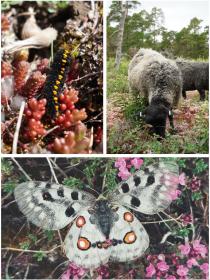Conclusions

Answers to the questions
1. What are the habitat preferences of the Apollo butterfly in its different life stages?
Larvae have a preference for habitat heterogeneity, and they utilise the variation in vegetation to thermoregulate. They also require a high cover and overall close vicinity to their host plant Sedum album. Adult butterflies have a preference for open areas with high abundance of different flowering nectar plants.
2. What impact does current grazing regimes in the study site have on larval and adult density?
The current grazing density in the study site has a severe negative impact on larval density. Also, grazed areas showed a trend of lower abundance of flowering nectar plants species within the circular plots. Thus, grazing might lower the habitat quality for adult butterflies since they prefer areas with high abundance of flowering nectar plants.
3. Are adult butterflies selective in their choice of nectar plants?
There is a trend towards a choice of specific nectar plant species, however they are selective in their choice of colour.

Conclusion
Based on the findings in the results, this study concludes that
habitat management of the Apollo butterfly on Gotland should
promote habitat heterogeneity and avoid the overgrowing from
tall bushes and trees. Due to the negative impact of grazing,
openness should primarily be maintained through manual mowing.
Responsible for this page:
Director of undergraduate studies Biology
Last updated:
05/17/21
